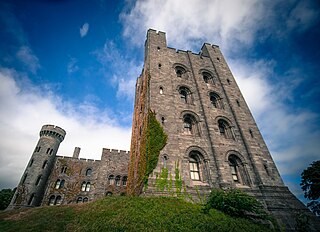At least three British ships have been named Lady Penrhyn for Lady Penrhyn (née Anne Susannah Warburton), the wife of Richard Pennant, 1st Baron Penrhyn, of the Penrhyn Estate in Llandygai, North Wales:
Richard Pennant, 1st Baron Penrhyn was the owner of Penrhyn estate, on the outskirts of Bangor, North Wales, six sugar plantations in Jamaica, and hundreds of enslaved African workers. He was a staunch anti-abolitionist and sat in the House of Commons between 1761 and 1790. He received an Irish peerage in 1783.

Penrhyn Castle is a country house in Llandygai, Bangor, Gwynedd, North Wales, in the form of a Norman castle. It was originally a medieval fortified manor house, founded by Ednyfed Fychan. In 1438, Ioan ap Gruffudd was granted a licence to crenellate and he founded the stone castle and added a tower house. Samuel Wyatt reconstructed the property in the 1780s.

Llandygai is a small village and community on the A5 road between Bangor and Tal-y-Bont in Gwynedd, Wales. It affords a view of the nearby Carneddau mountain range. The population of the community taken at the 2011 Census was 2,487. Llandygai community includes nearby Tregarth and Mynydd Llandygai.
- Lady Penrhyn (1783 ship) was an American vessel launched in 1777 that the British captured in 1782. Liverpool merchants purchased her and employed her in the African slave trade between 1783 and 1794. A squadron of the French navy drove her onshore on the coast of Africa in 1794.
- Lady Penrhyn (1786 ship) was built on the River Thames in 1786 as a slave ship. For her first voyage she transported convicts to New South Wales as part of the First Fleet. On her voyage back to Britain she was the first European vessel to pass by the Kermadec Islands, and the Penrhyn Atoll in the Cook Islands. She also carried a cargo for the British East India Company (EIC). The French captured her in the West Indies in 1811 and scuttled her.
- Lady Penrhyn (1875 ship) was a 3-masted iron-hulled barque of 838 GRT, launched at Glasgow in 1875. In October 1909 she stranded at Punta Gallegos; she was condemned in November.
Lady Penrhyn was an American vessel launched in 1777 that the British captured in 1782. Liverpool merchants purchased her and employed her in the African slave trade between 1783 and 1794. A squadron of the French navy drove her onshore on the coast of Africa in 1794.

Lady Penrhyn was built on the River Thames in 1786 as a slave ship. For her first voyage she transported convicts to New South Wales as part of the First Fleet. On her voyage back to Britain she was the first European vessel to pass by the Kermadec Islands, and the Penrhyn Atoll in the Cook Islands. She also carried a cargo for the British East India Company (EIC). The French captured her in the West Indies in 1811 and scuttled her.

The River Thames, known alternatively in parts as the Isis, is a river that flows through southern England including London. At 215 miles (346 km), it is the longest river entirely in England and the second longest in the United Kingdom, after the River Severn.
| This article includes a list of ships with the same or similar names. If an internal link for a specific ship led you here, you may wish to change the link to point directly to the intended ship article, if one exists. |
